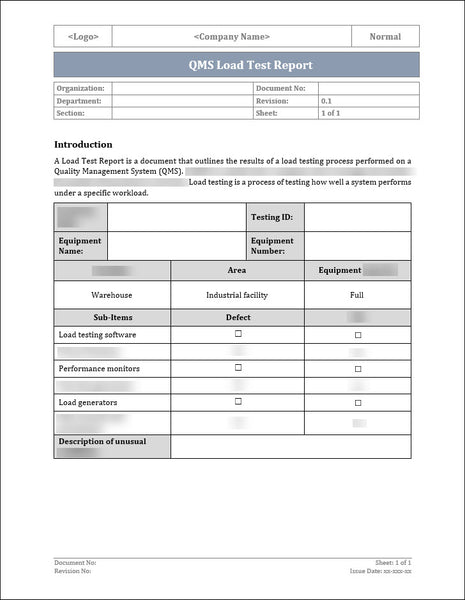ISO 9001 Load Test Report Template
Load test reports are critical in ensuring the quality and reliability of products and systems. In the context of ISO 9001, a load test report is documented evidence of a thorough examination and evaluation of a product or system's performance under various loads and conditions. This report helps organizations meet the requirements of ISO 9001 and provides valuable insights into the strengths and weaknesses of their products or systems. In this blog, we will explore the importance of load test reports in ISO 9001 and discuss how they contribute to overall quality management.

Understanding The Importance of Load Testing In ISO 9001
Load testing is a critical component of the ISO 9001 quality management system, ensuring that products and systems can perform under different load conditions. This testing method helps organizations identify potential issues or weaknesses in their products or systems, enabling them to make necessary improvements and enhancements. Furthermore, load test reports provide documented evidence of the evaluation process, ensuring compliance with ISO 9001 requirements.
By conducting rigorous load testing, organizations can validate their products' or systems' performance, reliability, and safety, vital for maintaining customer satisfaction and confidence. Load test reports also offer valuable insights into how a product or system behaves under different loads, allowing organizations to optimize their design and manufacturing processes. Ultimately, load test reports contribute to the overall quality management system by promoting continuous improvement and ensuring that products and systems meet the specified requirements.
Key Components of a Load Test Report
ISO 9001 is an international standard for quality management systems that ensures organizations meet customer requirements and enhance customer satisfaction. It is important to have a comprehensive and well-documented load test report to analyze and improve performance in load testing. Let's dive into a load test report’s key component that complies with ISO 9001.
1. Testing ID: Every load test should have a unique identifier that helps identify and differentiate between various tests. This ID should be mentioned at the beginning of the report to maintain clarity and traceability.
2. Equipment Information: A load test report must include details about the testing equipment used during the execution of the test. This includes the name, number, and any specific equipment identification. For instance, if load testing is done on a specific server, it should be mentioned in the report.
3. Location, Area, and Equipment Capacity: It is essential to mention the location and area where the load testing was conducted. This information aids in understanding the testing environment, as different locations or areas might have varying network conditions, which can affect the test results. Additionally, the capacity of the equipment used for load testing should be documented to ensure accurate evaluation.
4. Sub-Items: A load test involves various tools and components. The report should list these to provide a comprehensive overview of the testing process. The sub-items generally include:
5. Description of Unusual Conditions: During load testing, there might be unusual conditions, such as server failures, network disruptions, or unexpected errors. It is essential to document these conditions in the report. This helps in understanding any anomalies observed during the test and provides insights into potential improvements or corrective actions that can be taken.
The Purpose and Objectives of the Load Test Report
The load test report formally documents the load testing process and its findings. Its purpose is to provide a comprehensive overview of the performance and behaviour of a product or system under different load conditions. The objectives of the load test report are multi-fold.
Firstly, the load test report aims to present the test results clearly and concisely, highlighting any issues or weaknesses encountered during the testing process. This allows stakeholders, including management, engineers, and quality assurance personnel, to have a holistic understanding of the strengths and limitations of the product or system.
Secondly, the load test report provides an opportunity to analyze and interpret the test data, allowing organizations to identify patterns, trends, and potential areas of improvement. This analysis helps make informed decisions regarding product enhancements, design modifications, or process optimizations.
Thirdly, the load test report is formal evidence of compliance with ISO 9001 requirements. It demonstrates that the organization has conducted thorough load testing to ensure that the product or system meets the specified performance criteria and can perform reliably under expected load conditions.
Lastly, the load test report also plays a crucial role in communication and collaboration between different departments and teams within the organization. It enables effective knowledge sharing and facilitates discussions on potential design or process changes to improve the overall quality and performance of the product or system.
Conclusion
In conclusion, the load test report is an essential document in the ISO 9001 framework for evaluating the performance and behaviour of a product or system under different load conditions. Its purpose is to provide a clear and concise overview of the test results, highlighting any issues or weaknesses encountered during the testing process.

